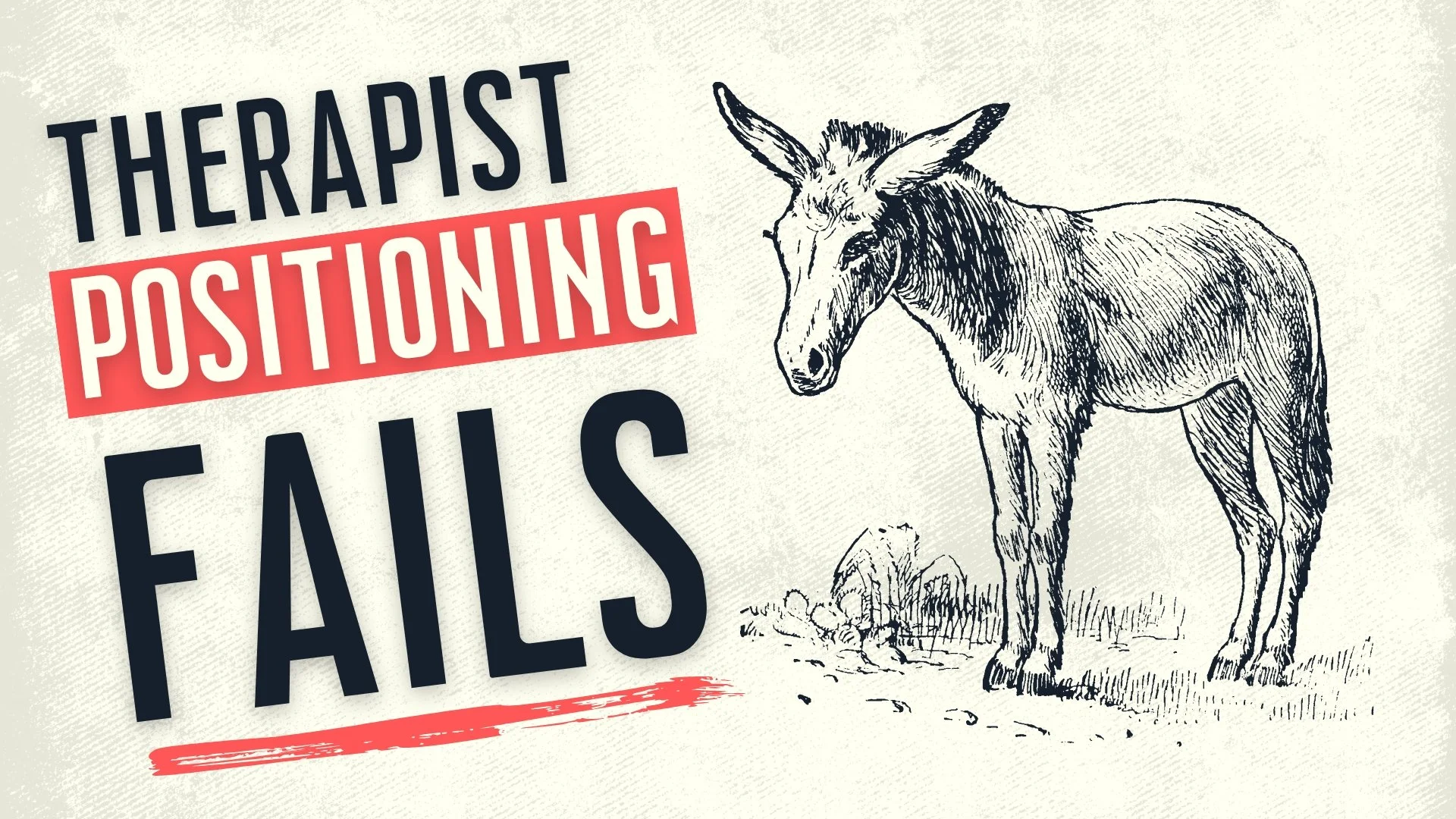Why Most Therapist Positioning Sucks (And Why TikTok Life Coaches Keep Winning)
Tired of being overlooked while unqualified coaches go viral? See 4 examples of bad therapist positioning—and how to fix yours with clarity and authority.
Let’s Be Honest
If your positioning sounds like: “I help people live their best life,” congratulations — you’ve officially joined the chorus of every other therapist, coach, and influencer with Canva.
And here’s the kicker: that 20-something “life coach” on TikTok giving half-baked advice? They’re getting the attention you’re not.
You’ve got the degree, the license, the hours, the expertise. They’ve got none of it. But what they do have is positioning that cuts through the noise.
That’s why it feels like nothing you’re doing is working. You’re qualified — but you’re invisible.
Why Safe Positioning Fails
Generic positioning feels safe. It feels professional.
“I help people with anxiety and trauma.”
“I’m committed to mental health and wellness.”
But safe positioning is why you’re being passed over.
Safe doesn’t stop the scroll. Safe doesn’t get quoted. Safe doesn’t get podcast invites.
Meanwhile, unqualified coaches aren’t afraid to be bold, polarizing, and specific. They’re saying things that make people pay attention — and because of that, they win the audience (and the opportunities).
Vanilla isn’t hated. Vanilla is forgotten.
Four Examples of Bad Positioning (That Keep You Invisible)
Here are four fake-but-realistic therapist profiles you could find in five minutes of scrolling. They look safe and professional — but they’re exactly why attention is slipping through your fingers.
Example 1: LinkedIn – The Job Title Trap
Bad Positioning:
“Licensed Professional Counselor at Private Practice.”
About: “Helping individuals, couples, and families heal and grow.”
Why It Fails:
This isn’t positioning. It’s a job description. Nobody is searching LinkedIn for “licensed professional counselor.” They’re searching for someone who gets them.
How to Reposition It:
“Helping ambitious women break free from high-functioning depression so they can stop performing and start living.”
That line polarizes. Some people scroll past. But the right person? They feel punched in the chest.
Example 2: LinkedIn – The Alphabet Soup
Bad Positioning:
“LPC, NCC, CADC, DBT Certified | Private Practice Owner.”
About: “Dedicated to evidence-based practice and lifelong learning.”
Why It Fails:
Clients don’t buy acronyms. They don’t care about your alphabet. They care about results. Alphabet soup looks professional but doesn’t persuade.
How to Reposition It:
“Helping first-generation professionals overcome anxiety without losing their drive.”
Now you’re not just licensed, you’re relevant.
Example 3: Instagram – The Quote Board
Bad Positioning:
Bio: 🌿 “Healing is possible.”
Feed: Canva quotes like “Self-care isn’t selfish.”
Why It Fails:
Inspirational quotes don’t build authority — they blur you into the background noise. When your feed looks like every other pastel-square “mental health” account, people forget you five seconds later.
How to Reposition It:
Bio: “Therapist helping millennial moms manage anxiety without losing themselves.”
Feed: Reels where you speak directly: “3 signs you’re not tired — you’re anxious.”
Quotes are generic. Voice is magnetic.
Example 4: Instagram – The Link in Bio Fail
Bad Positioning:
Bio: “Helping people find balance.”
Link: None...
Posts: Random memes.
Why It Fails:
You’re building an audience with nowhere for them to go. No free resource. No offer. No funnel. If there’s no bridge between your content and your work, you don’t have a platform. You have a hobby.
How to Reposition It:
Bio: “Therapist for ambitious professionals battling burnout. Grab my free 5-day stress reset below.”
Link: A simple landing page with your free resource + a strategy call option.
Now Instagram isn’t just where you “show up.” It’s where you convert.
Why This Matters (And Why Coaches Keep Winning)
Here’s the uncomfortable truth:
Unqualified coaches are beating licensed therapists because they’re not afraid to be loud, clear, and specific.
You’re cautious. They’re bold.
You’re leading with degrees. They’re leading with headlines.
You’re safe. They’re seen.
Every day you stick with safe positioning is another day you stay invisible while the noise wins.
How to Start Fixing It
Here’s your first move:
👉 Write down one client type you’d happily never see again.
That’s subtraction. And subtraction is the foundation of positioning.
From there, the real work is building clarity into every part of your presence — your bios, your website, your content, your collaborations. That’s not something therapists are taught, but it’s the skill that separates those who stay in the shadows from those who build real influence.
It’s why I built the Practice 2 Platform™ framework.
It helps therapists extract their unique voice, clarify their positioning, and activate a presence that actually gets noticed. In plain English: it helps you stop sounding like everyone else and start building a platform that attracts the right people and opportunities.
You don’t need more Canva quotes. You need clarity, confidence, and a strategy that makes you impossible to ignore.
Final Word
Safe positioning is costing you opportunities you’ll never even know you missed.
Stop sounding like everyone else. Stop losing to people who know less but say it louder.
Pick your lane. Get specific. Build a platform that makes you unforgettable.
Because if you don’t, someone far less qualified will keep eating your lunch.
👉 Action Step: Write down one client type you’d happily never see again. That’s your first step toward a real niche — and away from invisibility.
